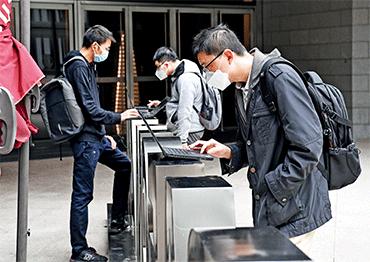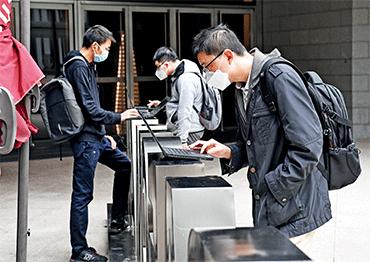However, the sudden change has caught millions of people not used to telecommuting unprepared to transition smoothly. Huang Xiaoxuan, a manager at a company that handles big data analysis, told her staff to download DingTalk and Tencent Meeting the night before work. To make sure everyone was getting up on time, the company scheduled daily 9am video meetings and enforced a dress code. But despite their efforts, many employees had trouble adjusting.
“When they’re working at home, everyone worries that if they don’t reply in time their boss might think they’re just idling around,” Huang said, adding that the constant checking of messages is a distraction she seldom dealt with at the office.
The new arrangement has been tougher for those in areas with poor data coverage. Wang Tao, who works for Lenovo Group in Wuhan, returned to his rural hometown for Chinese New Year. When Wuhan went on lockdown as the Covid-19 epicenter on January 23, his team migrated their meetings to Skype. But the data signal in his village was too weak and unstable to communicate effectively.
Hu Shichang, a planning director of an advertising agency in Hunan Province, faced the same struggle. To battle the poor data coverage and choppy signal, Hu was forced to repeat himself constantly during meetings. Also, he found that colleagues would often get distracted by their children or other domestic emergencies, which caused further delays in their work.
Hu told NewsChina that while working from home allowed him to get out of bed later, work-life boundaries became an issue. “My colleagues sometimes worked from 11 am until midnight. And they just assume you’re not sleeping. You have to work at least nine or even 11 hours a day,” said Hu, adding that without set office hours, clients often contacted him on weekends.
But the greatest challenges are coming from management. Huang told NewsChina that most of her job has been addressing the company’s concerns about maintaining efficiency, including whether employees were working hard or just sleeping in.
Huang realized her company was more focused on how much time employees were devoting to work. But spending less time or working from home does not necessarily mean lower efficiency. Instead of demanding that employees respond immediately to emails and messages, she adjusted the rules and set deadlines. As a result, she found telecommuting did not hinder communication within departments.
“Trust is essential,” said Xu Siyan, senior research fellow with the Tencent Research Institute. Xu explained that managers must trust that their employees working from home can perform as well or even better than at the office. Performance evaluations should focus more on results as a way to reflect this trust, Xu said.
Exploding demand proved equally challenging for online platforms. He Jing said that user requests for added functionality increased so sharply that despite his team working overtime, their products were on the brink of crashing on February 3, the day many companies resumed operations via cloud office tools.
DingTalk and WeChat Work reportedmillions of morning teleconferences all starting at once. Statistics from DingTalk show that more than 10 million companies and 200 million people signed on from home that day.
This urgency forced services to stay on their toes and constantly work on updates. Employees from Bytedance’s Feishu told NewsChina that the current test benchmark is whether collaboration tools are stable enough to meet a sudden spike in demand.
“The outbreak pushed the products into the market without allowing much time for preparation. We need more time to polish technical details to meet customer needs, and we need more users to help beta test products,” He said.

 Old Version
Old Version

